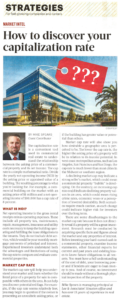How to Discover Your Capitalization Rate
The capitalization rate is a convenient tool used in commercial real estate to understand the relationship between the asking price of a commercial property and its net income. The cap rate is a simple mathematical ratio. Divide the yearly net operating income (NOI) by the asking price or appraised value of a building. The resulting percentage is what you’re looking for. For example, a commercial building on the market with an asking price of $1 million and a net operating income of $80,000 has a cap rate of eight percent.
What Is NOI?
Net operating income is the gross rental receipts minus operating expenses. These include all property tax, maintenance, repair, management, insurance and utility costs necessary to keep the building operating and fulfilling the lease obligations to the tenants. They do not include debt service, which would be your monthly mortgage payments of principal and interest. Experienced investors understand both the advantages and limitations of using the cap rate to compare and evaluate commercial properties.
Market Cap Rate
The market cap rate will help you understand your market and learn whether the listed price of a property for sale is comparable with others in the area. It can help you discover potential red flags. For example, if the cap rate seems relatively low, you may begin to question if the owner is presenting an unrealistic asking price, or if the building has greater value or potential than others.
Market cap rate will also show you how desirable a geographic area is perceived to be. The lower the cap rate is, the higher the asking price of a property will be in relation to its income potential. In west coast metropolitan areas, such as Los Angeles, San Francisco and San Diego, the cap rate is much lower than most cities in the Midwest or southern region.
A declining market cap may indicate a strong seller’s market, which could mean a commercial property “bubble” is developing. On the contrary, an increasing cap rate could indicate declining property values in an area, which could mean rising crime rates, economic woes or a perception of lowered desirability. Both scenarios require much caution, as each change could indicate higher risk for investors over the long term.
There are some disadvantages to the market cap rate because it does not directly reveal if a property will be a great investment. Research must be conducted by acquiring specific facts and figures about the market and any properties of interest. Before investing your hard-earned cash in a commercial property, examine income statements, other financial reports for current and past years and existing leases to know future obligations to all tenants. You must have a full understanding of the cost of debt, your borrowing power and if lenders are eager to loan money to you. And of course, no investment should be made without a thorough physical inspection of the property.
The article was published in the Houston Business Journal print edition (May 26 – June 1, 2017) on pg. 16.

